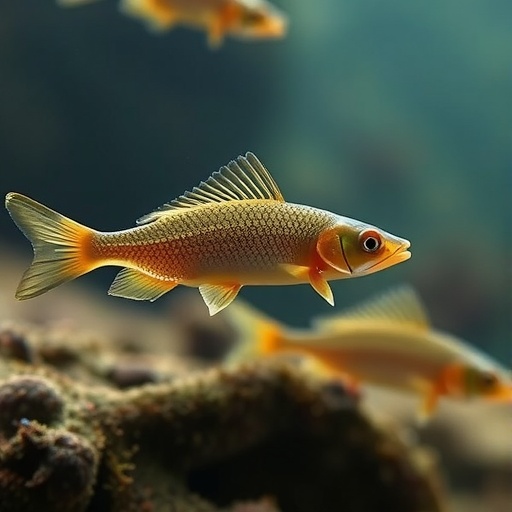A groundbreaking discovery in southwestern Alberta has unveiled a tiny fossilized fish that promises to reshape our understanding of otophysan evolution—one of the most diverse and widespread groups of freshwater fish known today. The newly identified species, named Acronichthys maccagnoi, hails from the Late Cretaceous period, a time when colossal creatures like Tyrannosaurus rex ruled the Earth. Despite its diminutive size of just four centimeters, this fossil offers a rare and invaluable window into the evolutionary history of otophysans, which include species as familiar as catfish, carp, and tetras, collectively accounting for about two-thirds of all freshwater fish diversity.
The research team, led by experts from Western University, the Royal Tyrrell Museum of Palaeontology, and international collaborators, conducted a rigorous examination of the Acronichthys skeleton, revealing features that have never before been documented in North American fossil records of this group. The study published today in Science highlights the significance of this find, which fills crucial gaps in the evolutionary timeline and provides concrete evidence pinpointing the origins of otophysans on the continent.
One of the most compelling aspects of the Acronichthys fossil is its position relative to the ancient Western Interior Seaway—a vast inland sea that split North America for millions of years. The fossil’s presence far inland from this ancient shoreline suggests complex ecological and evolutionary dynamics that may have influenced the transition of otophysans from marine to freshwater habitats, a pivotal step in their evolutionary radiation.
Otophysans are characterized by a unique anatomical feature: the modification of their first four vertebrae to create a highly specialized connection between the swim bladder and ear apparatus. This connection allows them to detect vibrations with remarkable sensitivity, effectively turning their swim bladder into an internal hearing organ akin to the human ear. Remarkably, this structural adaptation is visible even in the fossilized skeleton of Acronichthys, attesting to the early development of such evolutionary innovations.
Using state-of-the-art synchrotron beamlines at the Canadian Light Source and the Advanced Photon Source, researchers obtained high-resolution micro-CT scans of the fossil. This non-invasive imaging technology generates three-dimensional models by capturing consecutive two-dimensional X-ray images while rotating the specimen, preserving the fossil while revealing intricate internal bone structures that are impossible to analyze through traditional preparation techniques.
The utilization of micro-CT scans marks a significant advance in paleontological methodology. Many fossils collected from fragile sedimentary deposits are at great risk of damage during extraction or preparation. These micro-CT images therefore allow scientists to study minute anatomical details safely and with unparalleled precision, opening new frontiers in the study of fossilized fishes.
Beyond taxonomy, the discovery of Acronichthys maccagnoi provides critical insights into the biogeographical history of otophysan fishes. Current scientific consensus posits that otophysans originally inhabited marine environments before transitioning to freshwater. This newfound species bolsters this theory and suggests that freshwater colonization by otophysans occurred at least twice independently during their evolutionary trajectory.
By employing molecular clock techniques and fossil calibrations, the study recalibrates the divergence time marking otophysans’ shift from marine to freshwater ecosystems to approximately 154 million years ago during the Late Jurassic period—significantly after the breakup of the supercontinent Pangea began. This chronological refinement challenges previous models and invites new questions about how freshwater fish dispersed across continents separated by vast oceans.
Given that freshwater otophysan ancestors would have been confined to isolated river systems, the researchers ponder how these species managed to traverse what are now saltwater barriers. The puzzle of their transcontinental dispersal implies the possibility of ancient freshwater corridors or episodic marine tolerance events facilitating their spread, matters that future studies must explore.
While dinosaurs continue to capture popular imagination and scientific fascination, discoveries like that of Acronichthys maccagnoi underscore the vast unknowns in early freshwater ecosystems. As co-author Don Brinkman noted, the fossil sites in Canada are invaluable records that could unlock the evolutionary narrative of fish groups dominating modern rivers and lakes worldwide.
The implications of this discovery extend beyond paleoichthyology into evolutionary biology, historical biogeography, and even functional morphology. Researchers anticipate that continued investigation using advanced imaging and analytical techniques will uncover further mysteries about the adaptability and resilience of otophysan fishes through deep time.
Through international collaboration and the integration of cutting-edge technology, the unveiling of Acronichthys maccagnoi not only enriches the fossil record but also illuminates the complex evolutionary pathways through which biodiversity emerges and flourishes in freshwater habitats, offering a vivid reminder of the hidden stories embedded in Earth’s ancient past.
Subject of Research: Evolutionary origin and diversification of otophysan fishes
Article Title: Marine origins and freshwater radiations of the otophysan fishes
News Publication Date: 2-Oct-2025
Web References: DOI: 10.1126/science.adr4494
Image Credits: Don Brinkman (Royal Tyrrell Museum)
Keywords: Evolutionary biology, History of life, Otophysan fishes, Fossil discovery, Freshwater fish evolution
Tags: Acronichthys maccagnoi speciescatfish and carp originsdiverse freshwater fish groupsevolutionary history of freshwater fishfossilized fish researchgroundbreaking paleontological findingsLate Cretaceous freshwater fishNorth American fossil recordsotophysan evolution discoveriesprehistoric fish fossilsRoyal Tyrrell Museum researchWestern Interior Seaway significance





